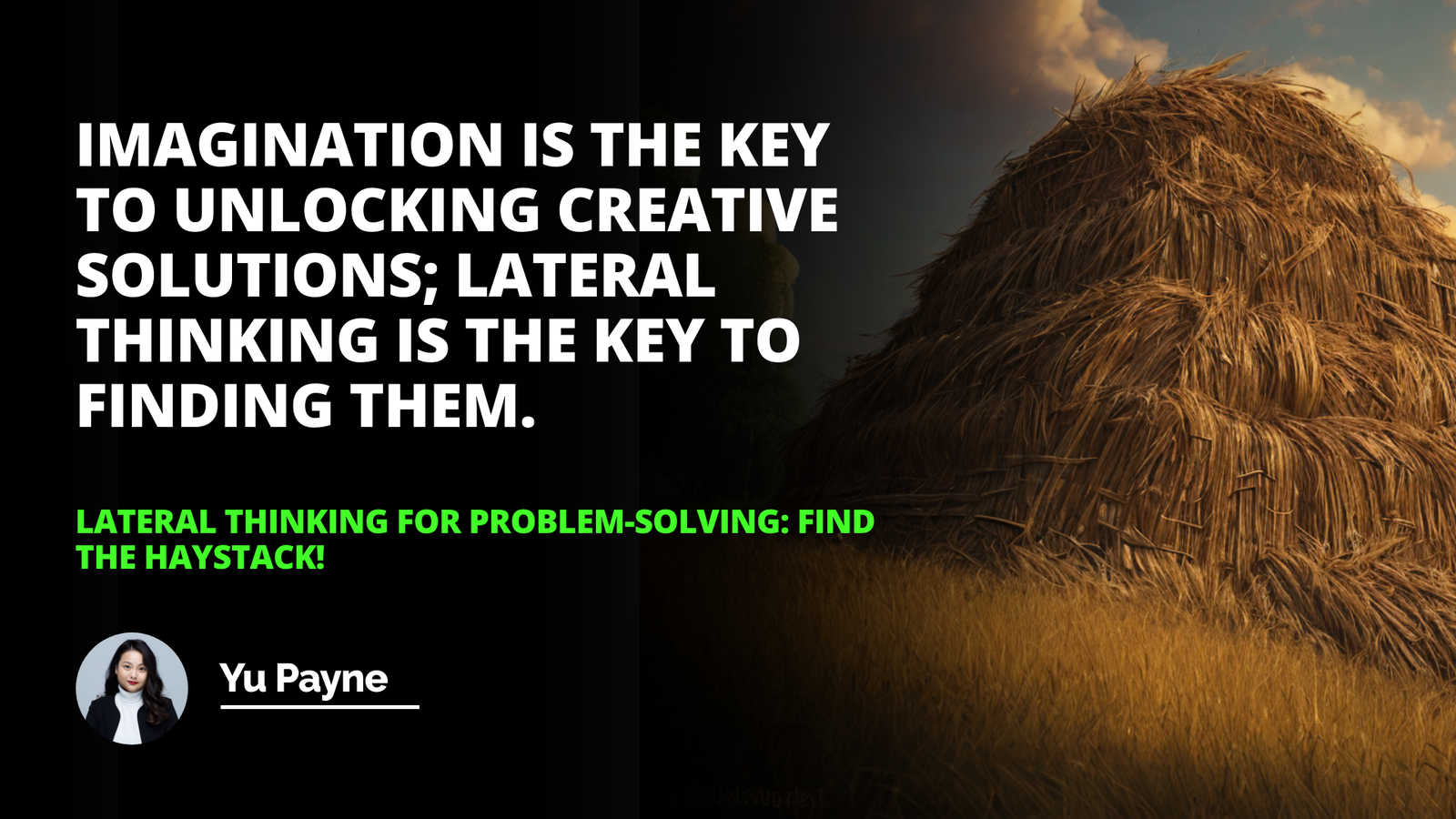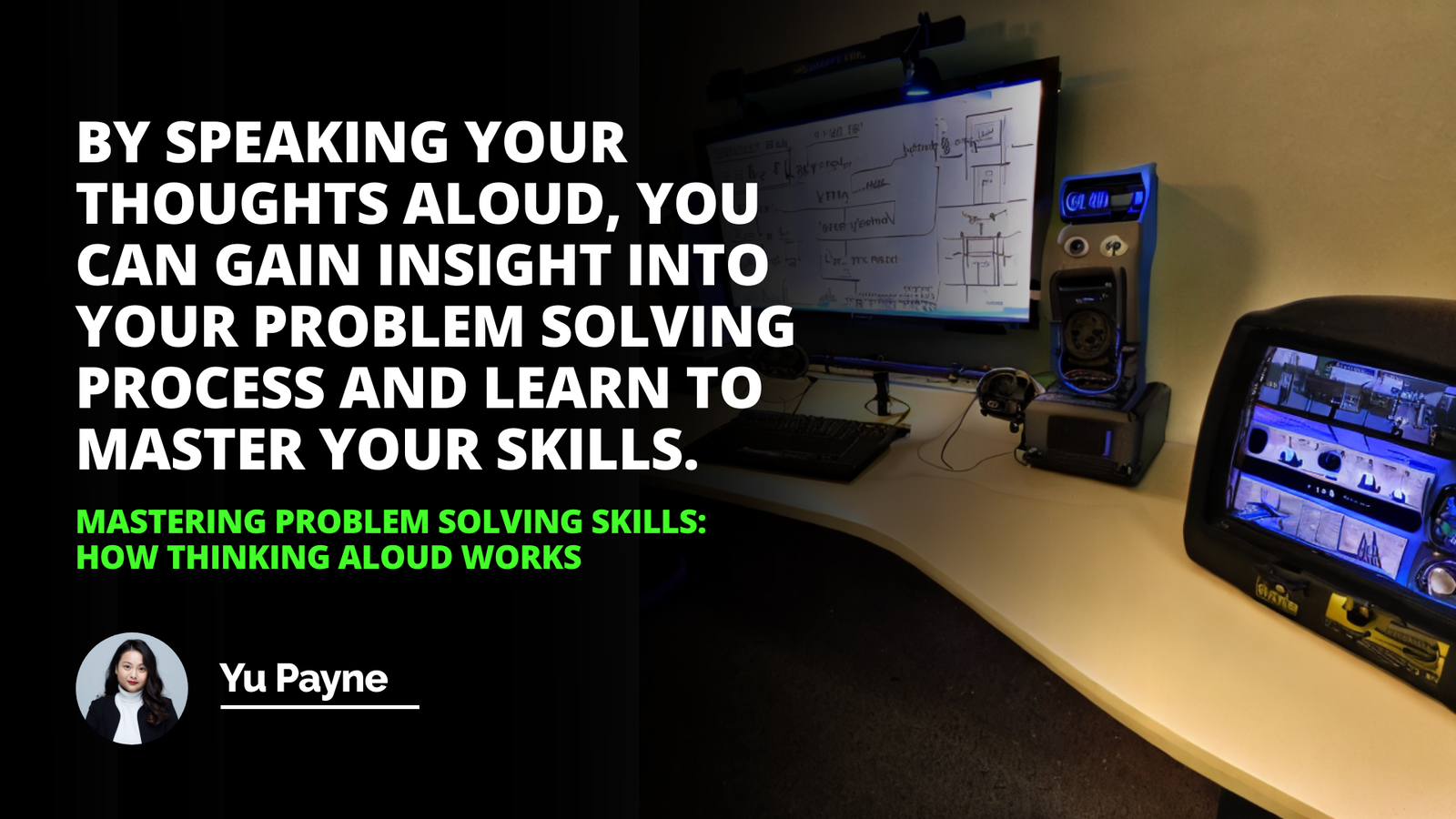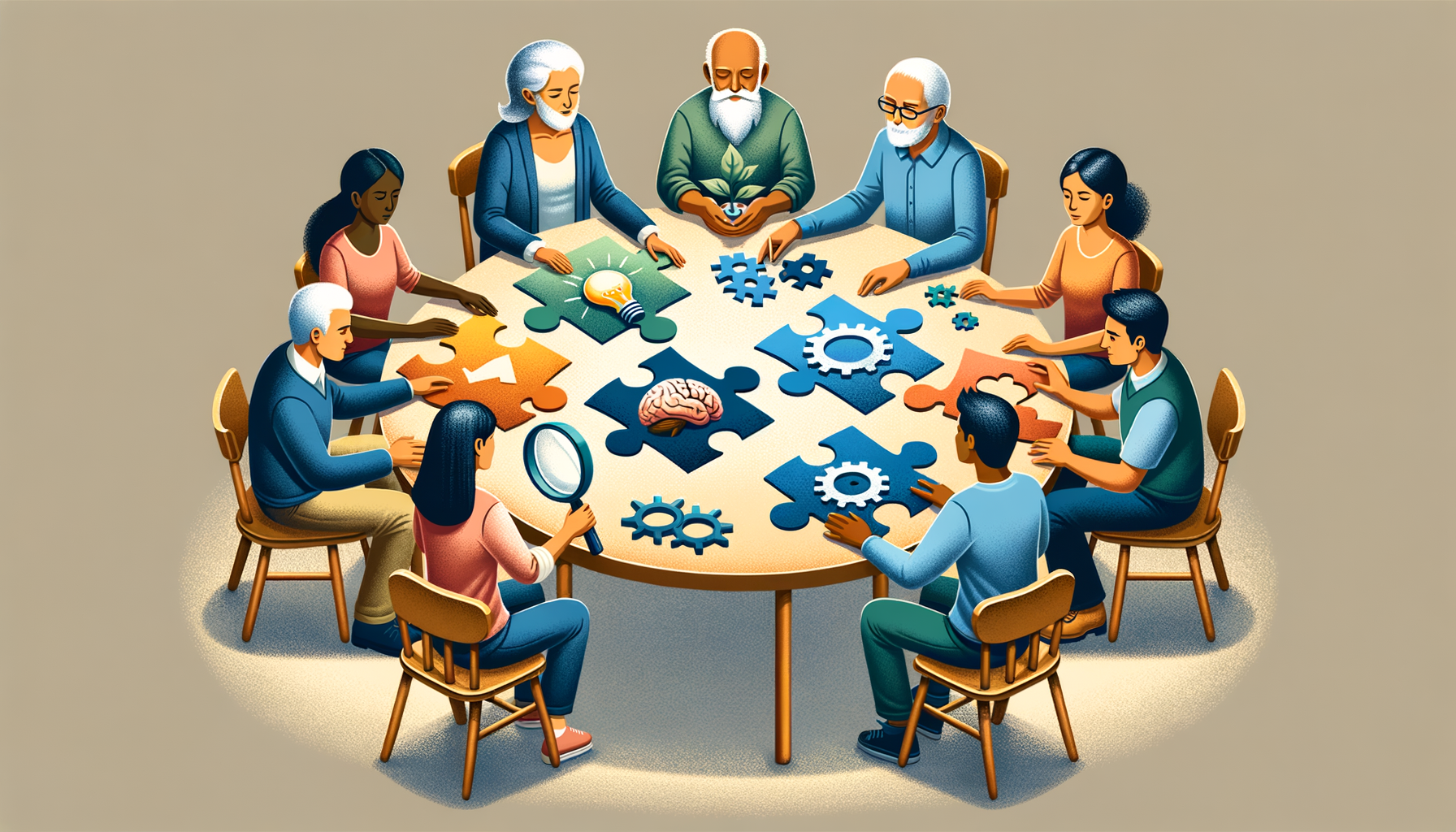
As someone who has always been fascinated by the inner workings of the human mind, I've spent countless hours exploring various cognitive processes and their impact on our daily lives. One concept that has particularly captured my attention is convergent thinking – a mental approach that focuses on finding the single, best solution to a problem. In this blog post, I'll dive deep into the world of convergent thinking, sharing my personal insights and experiences along the way.
The Essence of Convergent Thinking
At its core, convergent thinking is all about narrowing down options and zeroing in on the most effective answer. It's a process that relies heavily on logic, accuracy, and speed, drawing upon our existing knowledge and problem-solving techniques. When faced with a challenge, convergent thinkers ask themselves, "What is the most straightforward and reliable way to solve this?"
My Personal Encounter with Convergent Thinking
I vividly remember my first encounter with the power of convergent thinking. As a young student, I struggled with math, often getting lost in the sea of numbers and formulas. One day, my teacher introduced us to a step-by-step problem-solving method that required breaking down complex equations into smaller, more manageable parts. By systematically applying this convergent approach, I was able to tackle even the most daunting math problems with ease. This experience taught me the value of structured thinking and the importance of having a clear, logical path to follow.
The Building Blocks of Convergent Thinking
To truly grasp the concept of convergent thinking, it's essential to understand its key components. Critical thinking, for instance, plays a vital role in evaluating information objectively and forming well-reasoned judgments. Logical reasoning, on the other hand, ensures that our conclusions are valid and coherent, while an analytical approach helps us break down complex ideas into simpler, more digestible parts.
Convergent Thinking in Action
Now that we've covered the basics, let's explore how convergent thinking manifests itself in various aspects of our lives.
Convergent Thinking in Decision-Making
When it comes to making decisions, convergent thinking is often our go-to approach, especially when time is of the essence. By quickly assessing the available options and identifying the most promising one, we can make swift, confident choices. This is particularly crucial in high-pressure situations where indecision can lead to missed opportunities or negative consequences.
Real-Life Example: Choosing a Career Path
Imagine you're a recent college graduate, eager to embark on your professional journey. You have several job offers on the table, each with its own set of pros and cons. Using convergent thinking, you might create a list of criteria – such as salary, growth potential, and work-life balance – and systematically evaluate each option against these factors. By weighing the evidence and focusing on the most important aspects, you can confidently choose the career path that aligns best with your goals and values.
Convergent Thinking in Education
In the classroom, convergent thinking is often emphasized through activities that require students to find the one correct answer. Whether it's solving a math equation, identifying the capital of a country, or recalling a historical fact, convergent thinking helps students build a solid foundation of knowledge and develop problem-solving skills.
Personal Anecdote: Acing Multiple Choice Tests
As a student, I always found multiple-choice tests to be the perfect playground for convergent thinking. By carefully reading each question and eliminating the obviously incorrect answers, I could quickly narrow down my options and select the most plausible choice. This strategy served me well throughout my academic career, allowing me to excel in subjects that relied heavily on factual recall and logical reasoning.
Convergent Thinking in the Workplace
In professional settings, convergent thinking is a valuable asset, particularly when it comes to making strategic decisions and solving complex problems. By analyzing data, weighing pros and cons, and identifying the most effective course of action, convergent thinkers can help their organizations navigate challenges and seize opportunities.
Case Study: Streamlining a Manufacturing Process
Imagine you're a manager at a manufacturing plant, tasked with improving efficiency and reducing costs. Using convergent thinking, you might gather data on the current production process, identify bottlenecks and inefficiencies, and systematically evaluate potential solutions. By focusing on the most impactful changes – such as upgrading equipment, optimizing workflows, or training employees – you can develop a targeted plan to streamline operations and boost productivity.
The Limitations of Convergent Thinking
While convergent thinking is undeniably powerful, it's important to recognize its limitations. When relied upon too heavily, it can lead to rigidity, stifle creativity, and prevent us from considering unconventional solutions.
The Danger of Tunnel Vision
One of the main drawbacks of convergent thinking is that it can create a kind of tunnel vision, causing us to focus so intently on a single path that we overlook alternative possibilities. This can be particularly problematic when dealing with complex, multifaceted issues that require innovative thinking and fresh perspectives.
Personal Reflection: Overcoming Mental Blocks
I once found myself stuck on a particularly challenging work project, unable to find a solution despite my best efforts. I had been approaching the problem with a purely convergent mindset, trying to force a square peg into a round hole. It wasn't until I took a step back and allowed myself to think more divergently – brainstorming wild ideas and exploring unconventional angles – that I finally had my breakthrough moment. This experience taught me the importance of balancing convergent and divergent thinking, and not being afraid to think outside the box when necessary.
The Value of Divergent Thinking
To truly harness the full potential of our minds, it's crucial to cultivate both convergent and divergent thinking skills. While convergent thinking helps us find the most efficient and effective solutions, divergent thinking allows us to generate a wide range of creative ideas and explore multiple possibilities. By embracing both approaches, we can become more versatile and adaptable problem-solvers, ready to tackle any challenge that comes our way.
Conclusion
In a world that often demands quick, decisive action, convergent thinking is an invaluable tool. It allows us to cut through the noise, focus on what's important, and find the best path forward. However, as with any cognitive strategy, it's essential to use convergent thinking judiciously, recognizing its strengths and limitations.
By understanding the power of convergent thinking – and knowing when to balance it with divergent approaches – we can become more effective thinkers, decision-makers, and problem-solvers. Whether we're students striving for academic success, professionals navigating complex challenges, or simply individuals trying to make the most of our lives, convergent thinking is a skill that can serve us well.
So the next time you find yourself faced with a problem, take a moment to appreciate the incredible convergent thinking machine that is your mind. Embrace the clarity and focus it provides, but don't be afraid to let your divergent side shine too. After all, it's the interplay between these two modes of thought that truly unlocks our full potential.
Frequently Asked Questions
What is the role of convergent thinking in problem-solving and decision-making activities
Convergent Thinking in Problem-Solving
Convergent thinking stands at the core of problem-solving. It involves focusing on a finite number of solutions. This approach contrasts sharply with divergent thinking. The latter casts the net wide for possible solutions. Convergent thinking drills down to the most viable solution. Both modes of thinking are critical in decision-making.
The Process of Convergent Thinking
Convergent thinking begins with analyzing the available information. Problem-solvers examine data closely. They then apply logical reasoning. This leads to solutions that fit within established boundaries. Also, convergent thinking often involves using prior knowledge and experiences. These guide individuals toward the right answers.
The role of this form of thinking becomes more clear in certain contexts. Take standardized tests, for instance. Such assessments require convergent thinking. Test-takers must single out the one correct answer. There's little room for creativity or multiple perspectives.
In business decisions, convergent thinking plays a key part. Managers must often make choices based on limited data. They rely on convergent thinking to analyze risks and rewards. The goal is always to identify the singular best course of action.
Advantages of Convergent Thinking
Convergent thinking offers several clear benefits:
- Time efficiency: It leads to quicker decisions.
- Clarity: It yields clear-cut answers.
- Practicality: It focuses on workable solutions.
These advantages support its role in high-stakes environments. Deadlines and pressures demand swift, decisive action. Here, convergent thinking reigns supreme.
It is worth noting that convergent thinking requires critical thinking skills. Individuals must assess facts objectively. They must also apply logical reasoning meticulously.
Balancing Convergent and Divergent Thinking
The best problem-solving often comes from a balance. Divergent thinking expands the realm of possibilities. Convergent thinking then narrows it down. Together, they form a dynamic duo in decision-making.
Decision-makers benefit from starting with divergent thinking. They explore all potential avenues without restrictions. This phase is open-ended and creative. It sets the stage for convergent thinking to take over. After considering various possibilities, problem-solvers use convergent thinking. They focus on converging towards the single best solution.
In conclusion, convergent thinking plays a pivotal role in problem-solving and decision-making. It complements divergent thinking by bringing a necessary focusing lens. Together, they achieve a complete problem-solving strategy. Convergent thinking therefore remains invaluable across multiple domains. It ensures that decision-making is grounded, practical, and often, successful.
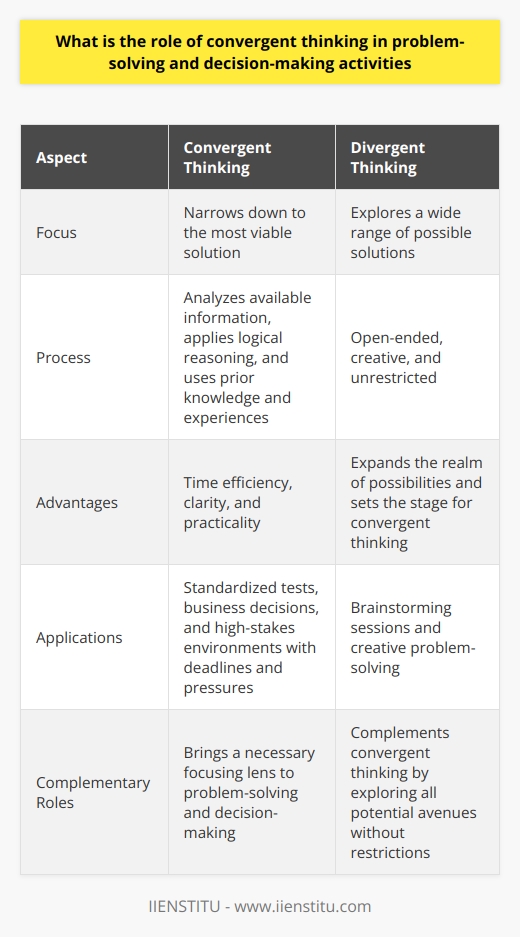
How does convergent thinking differ from divergent thinking in terms of psychological and cognitive processes
Convergent and divergent thinking stand at the core of cognitive processing. They represent two distinct paths the brain takes when tackling problems or generating ideas. In this blog post, we unravel the intricacies of both processes.
Convergent Thinking
This mode of thinking aims at finding a single, correct solution to a problem. It involves logic, accuracy, and an analytical approach. Often, convergent thinking employs deduction. It starts from a known principle and narrows down to a specific answer.
Key Features
- Linear and analytical
- Focused on the 'correct' answer
- Relies on fact-based problem-solving
Such thinking aligns with standard intelligence tests. They require one to converge on a single solution. In academic and professional settings, this approach prevails. Think mathematics or multiple-choice exams.
Psychological Processes
Convergent thinking taps into the left hemisphere of the brain. This does not imply that the right hemisphere remains inactive. But literature often associates the left with logic and detail orientation.
Cognitive Processes
When one engages in this mode of thinking, the cognitive process becomes more streamlined. Individuals use a step-by-step method. They discard irrelevant information. The process resembles a funnel, where various data points channel into one conclusion.
Divergent Thinking
Divergent thinking, by contrast, explores multiple possible solutions. It thrives on creativity, spontaneity, and free-flowing thought. Here, thinkers look to connect disparate pieces of information in novel ways.
Key Features
- Creative and non-linear
- Open-ended with many answers
- Encourages thinking 'outside the box'
The brainstorming sessions exemplify divergent thinking. There are no wrong answers. Innovation and art often require such an approach to thrive.
Psychological Processes
Divergent thinking engages the right hemisphere more. This side of the brain deals with intuition and holistic processing. Both hemispheres can collaborate, fostering creative insight.
Cognitive Processes
Cognitive flexibility becomes crucial in divergent thinking. Individuals entertain different ideas simultaneously. They cross boundaries of conventional thought. This process is like a tree. It starts with a single trunk and branches out in various directions.
Complementary Systems
Convergent and divergent thinking are not mutually exclusive. They complement each other. Together, they form a comprehensive problem-solving toolset.
In Practice
- Convergent thinking defines the problem.
- Divergent thinking generates creative solutions.
- Then, convergent thinking evaluates these solutions.
Innovation often arises from this interplay. One must diverge to explore possibilities and converge to implement solutions.
Cognitive Flexibility
Flexibility lies at the heart of toggling between these thought processes. It lets us adapt our thinking to the demands of different situations.
Enhancing Cognitive Flexibility
- Embrace diverse experiences.
- Cultivate curiosity.
- Engage in both critical and creative exercises.
By developing cognitive flexibility, we enhance our ability to think in both convergent and divergent ways.
In summary, while convergent and divergent thinking use different psychological and cognitive processes, they both serve vital roles in intellectual functioning. Understanding and honing both can lead to a more versatile and innovative approach to problems in various domains of life.
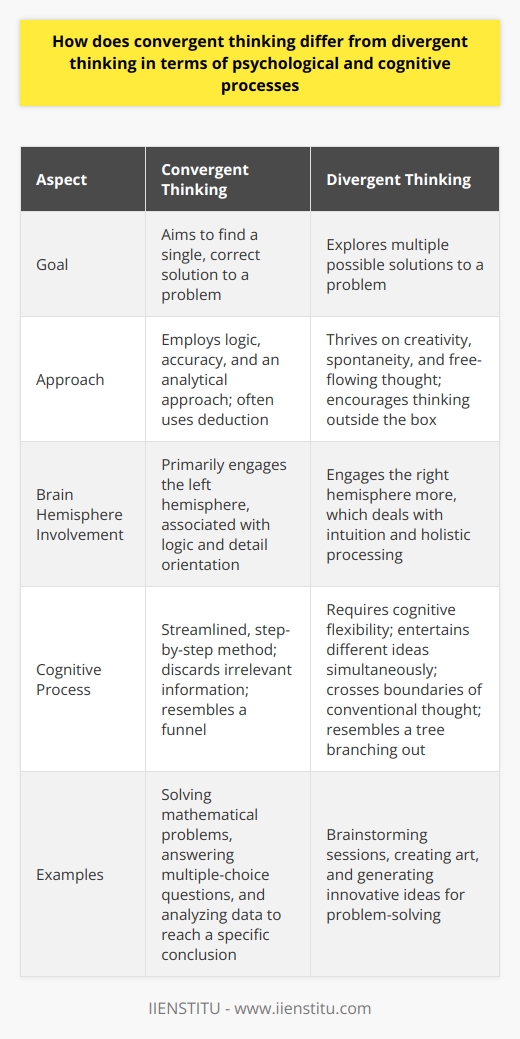
What are some practical applications of convergent thinking in real-world situations?
Convergent Thinking in Practice
Convergent thinking stands as a cognitive process wherein a single, well-defined answer to a problem is deduced. Experts often contrast it with divergent thinking, where multiple solutions are possible. In practical settings, convergent thinking proves invaluable. It drives efficient decision-making and problem-solving.
Applications in Daily Life
Decision-making relies heavily on convergent thinking. Each day, individuals face choices. One must consider various options. Ultimately, a single decision is necessary. Convergent thinking helps distill options into a clear choice.
Budgeting is a typical task requiring convergent thinking. Individuals receive a finite amount of resources. They must allocate these wisely. This need for optimal distribution calls for a focused approach. Convergent thinking leads to efficient budgeting.
Problem-Solving in the Workplace
In professional settings, convergent thinking is essential. Project management is a clear example. Teams face deadlines and defined goals. Convergent thinking helps identify the most direct path to project completion.
Conflict resolution within teams also benefits. Disputes arise from differing perspectives. A common ground must be found. Convergent thinking guides disputants toward a mutually agreeable solution.
Innovation and Design
Though often associated with divergent thinking, innovation requires convergence. In the development process, myriad ideas emerge. Yet, a single, viable product must be selected. Efforts converge to refine the final invention.
Design also requires convergent thinking. Designers create various drafts. They explore numerous possibilities. Finally, they must select a single, coherent design. Convergence allows for the refinement of ideas into practical applications.
Educational Settings
In education, convergent thinking is paramount. Standardized tests are designed for convergent responses. Takers must find the one correct answer. Teachers assess students' ability to apply convergent thinking.
Scientific Research
Research often employs convergent thinking. Scientists propose multiple hypotheses. Through experimentation, they exclude the incorrect ones. They converge on the most plausible explanation.
Medical Diagnosis
In the medical field, accurate diagnosis is critical. Patients present with various symptoms. Doctors use convergent thinking to determine the underlying condition. They rule out other potential causes to find the correct diagnosis.
Legal Proceedings
Within the legal system, evidence is key. Attorneys and juries face conflicting testimonies. They must assess the credibility of each. Convergent thinking leads to the most probable narrative of events.
Crisis Management
Crisis management demands rapid, convergent decision-making. Leaders receive a flood of information. They must respond quickly. Drawing conclusions from available data, they decide on the best course of action.
Convergent thinking enables people to navigate the complexities of life. It guides actions and decisions across varied contexts. Its practical applications span from the mundane to the critical, reflecting the profound impact of focused cognitive processing on real-world situations.


